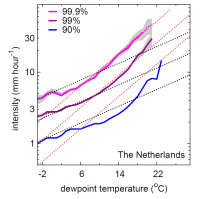The showers that occurred on the 28 June 2011 were exceptional. In Vught, located 15 km north of Eindhoven, a downburst associated with these showers caused severe wind damage, and further north in Herwijnen 79 mm of rain fell in one (clock) hour, between 2000 and 2100 local time. It turns out that this hourly precipitation sum was the highest recorded at any observational station in the Netherlands. Notably, the 4 highest observations were all recorded in the last 10 years. Despite the fact that the station density in the last 15-20 years is higher than before, this is a remarkable finding.
The time evolution of temperature, dew point temperature and 10 minute precipitation is shown above. It is shown that just before the shower the temperature was around 30 °C. But more importantly, with a dew point temperature of close to 23 °C in the last few hours before the shower the absolute humidity of the air was unusually high for the Netherlands. At the onset of the shower the temperature dropped by almost 10 degrees in 10 minutes time. Also the dew point temperature decreased by several degrees, but not as dramatically as the temperature itself. The drop in dew point temperature, hence absolute humidity, is most likely caused by the transport of drier air from aloft to the surface due to the turbulent motions of the convective cloud.
Finally, we discuss how such an event could change in the future. We showed that hourly precipitation extremes are generally expected to increase at a rate of 10-14 % per degree. However, the results from Hong Kong show that the increase in intensity with dew point temperature breaks down at a dew point of 23 °C. For higher dew point temperatures the intensity does not increase further with temperature. It is not known whether such a limitation also exists for the Netherlands, although this appears likely. As the dew point temperature in this event is close to the threshold of 23 °C, we may expect no further increases of the intensity with global warming.

Yet, the event on 28 June 2011 could be viewed as a prototype of events that may occur more frequently in the future climate. In the present climate the far majority of extreme convective precipitation occur for dew point temperatures below 20 °C. With a typical predicted warming at the end of this century for western Europe of 3 °C, many more precipitation events will occur close to the threshold of 23 °C. From the present-day distribution the estimated increase in frequency is approximately a factor 5. This could imply that events like “Herwijnen” will be become a much more common feature of summer time precipitation by the end of this century.